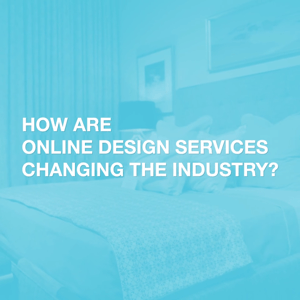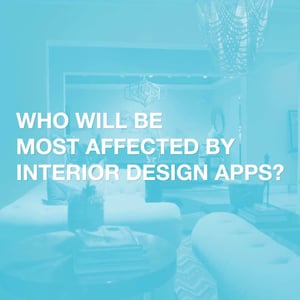
Virtual interior design services, known by the term “e-design,” have been a hot topic within the industry for nearly a decade, when the first e-design firms hit the scene. While the players have changed, the game has remained the same: e-design is interior design conducted remotely, where the designer never physically visits the space, but communicates with the client virtually and relies on the client to provide measurements of the space and installation of the designer’s recommendations. Traditionally, interior designers who create luxury designs have shied away from e-design, as the space has been saturated with low-cost providers and therefore has naturally attracted clients with smaller budgets.
But the COVID-19 crisis has put e-design into a new light, as all interior designers have been forced to deliver their services virtually, at least temporarily. There is a strong chance that e-design will become permanently popular with a much wider audience than in pre-pandemic times, offering interior designers of all types an opportunity to enter the space in a way that strengthens, rather than degrades, their existing business.
E-Design in the Pre-Pandemic World
Prior to the coronavirus, the e-design space was dominated by large companies, like Modsy and Havenly, where fees for starter packages are below $100. These companies also have official partnerships with affordable product companies, like Crate and Barrel and West Elm, which help generate profits for their companies (which are low margin, and in some cases, operating at a loss), while keeping the overall project cost low for the end client.
This has made it hard for designers who offer a higher level of service and a more nuanced style in their e-design – which should be more valuable – to find clients willing to pay fees that are closer to what that designer would make in their traditional business model, where they are visiting the space and controlling the process from beginning to end. However, some high-end designers supported the concept, if not offering e-design themselves, and a handful fully-embraced it by launching $1000+ luxury e-design packages of their own.
Robin Baron of Robin Baron Design has long held a positive view of e-design, and within the last year (before the pandemic), began developing a new e-commerce site that will feature her own products, as well as a curation of other designers’ products, which she plans to launch within the next three months.
Some interior designers not offering e-design specifically still have seen an increase in demand from clients outside of their locale, and have found a way to complete projects remotely. Bayberry Cottage designer, Amber Fae, describes how this works:
There is definitely a trend toward e-design, specifically now. It's not something we've marketed toward at all, but people are reaching out from all over the country. They've found our website, they love our style, and they reach out to ask if we would possibly consider working with them long distance. We have completed three long-distance designs, site unseen, and are just beginning two more projects this month. Just like with our local clients, constant, clear communication is key to success.
Heidi Semler of Heidi Semler Interior Design, says:
With our clients we have found that they have been very eager to have "virtual" meetings with Heidi. Whether it be rearranging the layout of their living room, sourcing new furniture, or even material selections for a remodel project. We typically put together a google slide presentation for the client and then Heidi will either have a zoom meeting with the client to go over the presentation. The clients have commented that they love the efficiency and that they feel comfortable making decisions off of the presentation. We will of course order physical samples and have them ship directly to Heidi and the client. We have found the virtual design space to be working pretty well!
Other luxury interior designers are updating their business model to embrace, micro decorating, a term coined by Architectural Digest’s Catherine Hong. Micro decorating refers to the practice of decorating only one room or one facet of a site, which has traditionally been reserved for new designers just starting out in the industry. The interior design industry has been transforming over the last few years, as the dominance of digital and the mainstreaming of social media has made it easier for potential clients to find designers around the world, and harder for designers to dominate their local market.

It appears that the coronavirus is accelerating these trends. When the world went into quarantine this March, it drove a mass of interior designers onto e-design platforms, like eDesign Tribe and Decorist. While it’s difficult to determine if many of these hasty converts will find long-term success with e-design, or if they will quickly return to their traditional model when social-distancing is no longer a mandate, this pandemic experience certainly creates an opening for e-design to expand to a much wider audience with a higher budget ceiling.
Post-COVID role of E-Design
There is little question that all interior designers will need to adapt to a post-pandemic future, which at the very least, will require polished virtual communication and a plan for working remotely, should the need suddenly arise again. It’s likely that people will generally be more cautious about social interaction, so while as an interior designer, you may not want to develop branded e-design packages, you have to think about how and what you are willing to do virtually on a client-to-client basis. All interior design will have more e-design elements, so invest in the technology to be as digitally capable as possible.
David Charette of Britto Charette, believes e-design will further separate interior decorators from interior designers, who are able to offer not only a unique, personalized aesthetic to a project, but also the architectural knowledge to lead the building process and integrate with other important components, such as security experts and landscape architects. And he agrees that having a mastery of communication technology is important to thriving in today’s world, where his clients are traveling the world at any given time and many of their vendors are international. He explains,
“Ultimately, interior design comes down to the process. Nothing beats visiting a site. We measure, we research, we measure again. We also manage client expectations, and that takes interfacing with the client, the vendors, the trades—all of the stakeholders. The beauty of technology is that we can conduct many of our meetings through Zoom or similar platforms and reduce in-person and face-to-face interactions. That ability is a critical component of our delivery of service and not just something done as a result of the pandemic.”
He also feels it’s important to respond to the rise of e-commerce, especially now that Instagram and Facebook are integrating shop-the-look capabilities. While Britto Charette does not intend to develop an e-design offering, per se, Operations Principal Pedro Cabas says, they are considering how to incorporate Checkout and Instagram Shopping in the future.
Looking at the bigger picture, now is the perfect time to at least analyze how an e-design offering could benefit your business. Robin wisely says,
“If you decide to stay where you are, do it because you thought it through. It makes sense for you to stay where you are. However, if it’s because you are scared, confused, or don’t want to take the time, those are not good reasons. Make staying where you are a conscious decision.”
People around the world are facing the same two problems that create a perfect storm for e-design demand: looming economic recessions and a strong desire to refurbish their homes, in which they now spend significantly more time. People want to invest in interior design, but are afraid to spend lavishly when their financial futures are uncertain. If the economic recessions are particularly bad, many traditional, luxury interior design businesses could be forced to close permanently. Developing an e-design business could be necessary to future survival, so use this moment of relative stability to determine if you want to take this route, and if so, to develop a carefully planned strategy.
With more big name, high-end interior designers entering the e-design space, like Robin, Bria Hammel, and Marie Burgos, for example, it will be more feasible for all interior designers to demand fees that match their services. It’s important not to reduce the fees you charge for the same level of service you provided pre-pandmeic, and while e-design will naturally be lower cost than traditional design because the client is taking on more responsibility, the designer must still be compensated appropriately.
It’s also essential to develop e-design packages that match your brand and imbue a sense of who you are as a designer. Instead of jumping on the bandwagon with a generic, poorly planned offering, customize packages that highlight what you bring to the table as an individual. Also, consider working with your lawyer on writing terms for your e-design contracts that ensure your client follows through on what you expect from them, and that the final result of the project matches what you designed.
While these are uncertain times, interior design is an industry uniquely positioned to benefit from the cultural changes that came suddenly and are here to stay. While traditional interior design, where designers can have the lion’s share of control over their projects and personal connections with their clients, will always be the preferable route for many, e-design cannot be overlooked as a passing fad. Interior designers who can adapt will always have a place to hang their metaphorical shingle.



